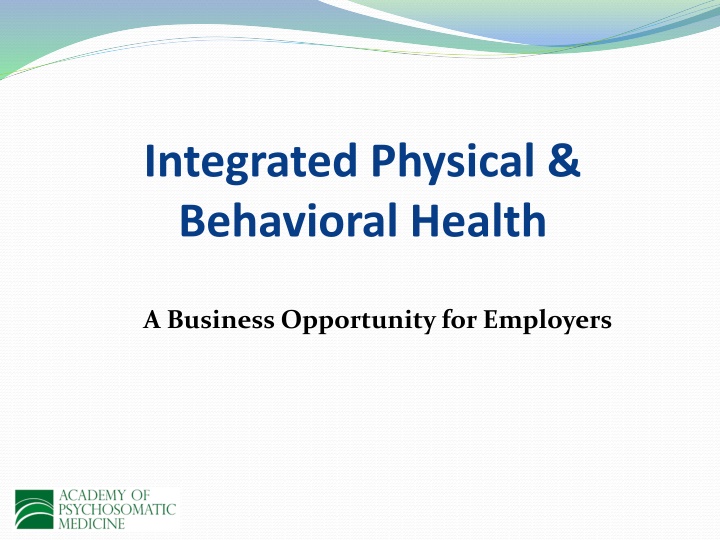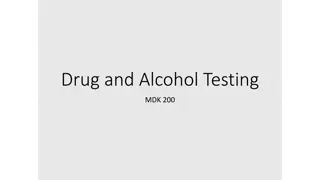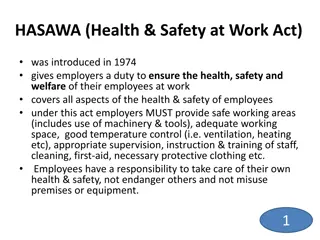
Business Opportunity in Integrated Physical & Behavioral Health for Employers
Explore the benefits of integrating physical and behavioral health care for employers. Discover how treating behavioral difficulties in primary care can impact employee health costs and productivity. Understand the delivery of care in both sectors and the comparatively small direct costs to employers. Learn about the lost productivity costs associated with behavioral disorders and their prevalence in the workforce.
Download Presentation

Please find below an Image/Link to download the presentation.
The content on the website is provided AS IS for your information and personal use only. It may not be sold, licensed, or shared on other websites without obtaining consent from the author. If you encounter any issues during the download, it is possible that the publisher has removed the file from their server.
You are allowed to download the files provided on this website for personal or commercial use, subject to the condition that they are used lawfully. All files are the property of their respective owners.
The content on the website is provided AS IS for your information and personal use only. It may not be sold, licensed, or shared on other websites without obtaining consent from the author.
E N D
Presentation Transcript
Integrated Physical & Behavioral Health A Business Opportunity for Employers
About the Health and Health Costs of Your Employees 80% of employees with behavioral difficulties (~20% of employer covered lives) are seen and treated in the primary care sector (without access to behavioral specialists) On average, behavioral health conditions add about $1,600 in direct behavioral health treatment cost and lost productivity and about $3,200 in use of additional physical health services Current carved out and carved in insurance products prevent physical and behavioral service integration and contribute more than $130 annually to total health costs
Delivery of Physical and Behavioral Care Physical Health Outpatient Sector Physical Health Inpatient Sector Chronic Illness 80% Health Complexity Behavioral Conditions 20% Behavioral Condition Treatment in the Physical Health Sector ~80% of behavioral health patients ~3% of behavioral health budget ~10% of behavioral health providers Behavioral Health Sector ~20% of behavioral health patients ~97% of behavioral health budget ~90% of behavioral health providers Mark TL et al, Health Affairs, 30:284-292, 2011
Comparatively Small Direct Cost of Behavioral Care to Employers Percent Prevalence 464 1% 12% Percent affected Inpatient Direct Cost $358,978 40% Inpatient $4,050 Professional/ Outpatient Professional/Outpatient $142,330 59% Pharmacy Pharmacy $212,589 Per Diseased Employee $774 Per Employee $89 4,031 employees Johnston et al: JOEM 51, 564-577, 2009
Lost Productivity Costs of Behavioral Disorders Prevalence 464 Percent 12% 6% Percent affected FMLA 9% Direct Cost $404,782 Family Leave $36,574 Absenteeism 28% Absenteeism $232,020 Presenteeism Presenteeism $113,2030 Short Term Disability $22,984 57% Short Term Disability Per Diseased Employee $872 Per Employee $100 4,031 employees Johnston et al: JOEM 51, 564-577, 2009
Behavioral Disorders Add about $3,300/Employee to Medical and Pharmacy Costs (Based on 120,500 Employees with Commercial Coverage) $10,000 9961 9145 1752 $9,000 1531 2000 & 2001 Medical services and medications account for ~80% of costs for employees with behavioral conditions $8,000 2311 $7,000 2010 $6,000 4826 5899 $5,000 5603 4317 917 777 $4,000 3909 $3,000 3540 $2,000 $1,000 $0 Medical Service Use Only Some Behavioral Condition Service Use 2000 2001 2000 2001 Behavioral Claims Cost Pharmacy Claims Cost Medical Claims Cost Kathol et al, JGIM, 2005--sub analysis of commercial population
Total Health-Related Costs of Untreated Behavioral Disorders in 100,000 Employees Per Affected Employee Per Employee Per 100,000 Employees Direct Behavioral Cost $774 $89 $8,900,000 Productivity Cost $872 $100 $10,000,000 Associated Medical Cost $3,300 $380 $37,950,000 Total $4,946 $569 $56,850,000
Concurrent Behavioral Conditions in Employees with Chronic Medical Conditions Show Similar Patterns but Substantially Higher Cost Annual Cost of Care Patient Groups Illness Prevalence % with Comorbid Mental Condition* Annual Cost with Mental Condition % Increase with Mental Condition All Insured Arthritis Asthma Cancer Diabetes Chronic Pain $7,320 CHF Migraine COPD $2,920 $5,220 $3,730 $11,650 $5,480 6.6% 5.9% 4.3% 8.9% 1.1% 1.3% 8.2% 8.2% 15% 36% 35% 37% 30% 70% 40% 43% 38% *Approximately 10% receive evidence-based mental condition treatment $10,710 $10,030 $18,870 $12,280 $15,840 $17,200 $10,810 $10,980 94% 169% 62% 124% 116% 76% 149% 186% $9,770 $4,340 $3,840 Cartesian Solutions, Inc. --consolidated health plan claims data
Traditional Behavioral Health Management* (Shifts Behavioral Condition Costs to General Medical Benefits) Introduced Behavioral Health Management Practices Behavioral Condition Service Users (Test Group) Non-Behavioral Condition Service Users (Control Group) Decreased 38% ($1,912 to $1,192 BH Expenditures -- Increased 36.6% ($2,325 to $3,175) Increased 1.4% ($1,297 to $1,315) Non-BH Expenditures Increased $130/employee ($4,241 to $4,369) Increased $18/employee ($1,297 to $1,315) Net Total Cost of Care Increased 21.9% (6.4 to 8.7) Decreased 10.8% (4.0 to 3.6) Days Absent from Work *managed behavioral health organizations (MBHOs) Rosenheck et al, Health Aff 18:193-203, 1999 9
Integrated Care in Multiple Settings Improves Employee Health and Reduces Cost Depression and diabetes: 115 fewer days of depression/year; projected $2.9 million/year lower total health costs/100,000 diabetic members1 Panic disorder in PC: 61 fewer days of anxiety/year; projected $1.7 million/year lower total health costs/100,000 primary care patients2 Substance use disorders with medical compromise: 14% increase in abstinence at 6 months (69% vs. 55%); $2,050 lower annual health care cost/patient in integrated program3 Delirium prevention programs: 30% lower incidence of delirium; projected $16.5 million/year reduction in IP costs/30,000 admissions4 Unexplained physical complaints: no increase in missed general medical illness or adverse events; 9% to 53% decrease in costs associated with increased healthcare service utilization5 Health Complexity: halved depression prevalence; statistical improvement of quality of life, perceived physical and mental health; 7% reduction in new admissions at 12 months6 Proactive Psychiatric Consultation: doubled psychiatric involvement with nearly one day shorter ALOS and 4:1 to 14:1 return on investment7 Data from 1. Katon et al, Diab Care 29:265-270, 2006; 2. Katon et al, Psychological Med 36:353-363, 2006; 3. Parthasarathy et al, Med Care 41:257-367, 2003; 4. Inouye et al, Arch Int Med 163:958-964, 2003; 5. summary of 8 experimental/control outcome studies; 6. Stiefel et al, Psychoth Psychosom 77:247, 2008; 7. Desan et al, Psychosom 52:513, 2011
Integrated Care Enhances Productivity Treatment (N = 158) Usual Care (N = 168) p Max. Productivity Baseline 2 years Hours Work Lost Baseline 2 years Treatment Value 72% 68% 23 13.5 72% 76% 23 4.5 $ 1,982/year/depressed FTE NS .03 NS .08 Rost et al, Med Care 42:1202-1210, 2004
Capturing the Business Opportunity Purchasing Health Insurance Products for Employees Desired Outcome--employee access to coordinated physical and behavioral services Important contract features for physical and behavioral health care delivery support Contract with a single integrated network of physical and behavioral providers that use a common electronic health record Contract uses common physical and behavioral payment adjudication procedures Contract allows employees access to an integrated network of behavioral and physical health providers driven by illness prevention and health outcomes that achieve the Triple Aim (improved health, lower cost, better delivery experience), e.g., accountable care organization, clinically integrated network of providers Core Health Benefit Contract Components Behavioral services are part of physical health benefits with similar/identical payment procedures Behavioral health providers are core members of the physical health physician provider network Single enrollee identifier for physical and behavioral health service use Colocation and close communication expectation for physical and behavioral services delivery, such as with collaborative care teams Integrated physical and behavioral health care/case management support procedures and payment for complex, complicated, comorbid, high cost employees Common claims and quality improvement data set for all physical and behavioral health service use






















